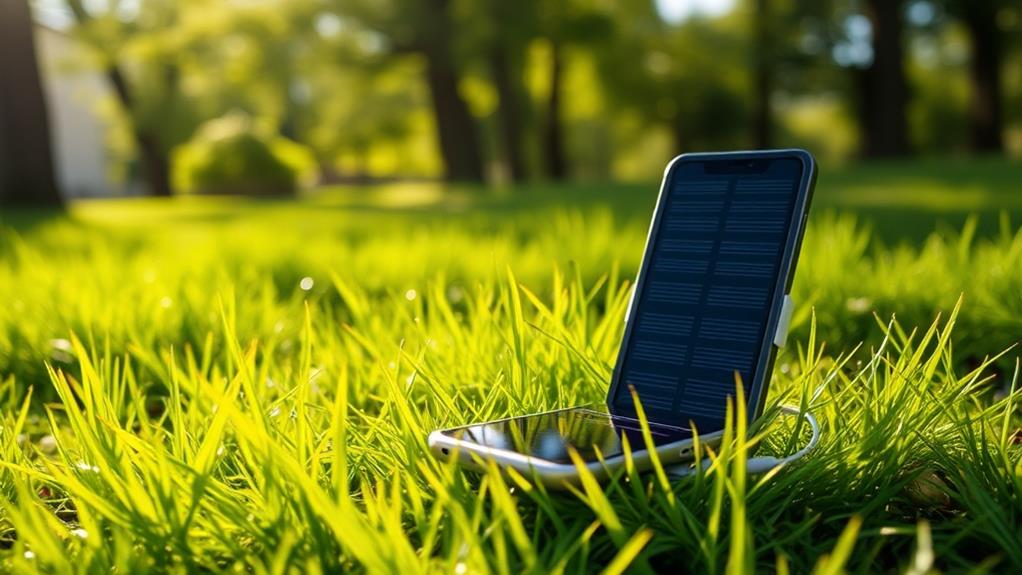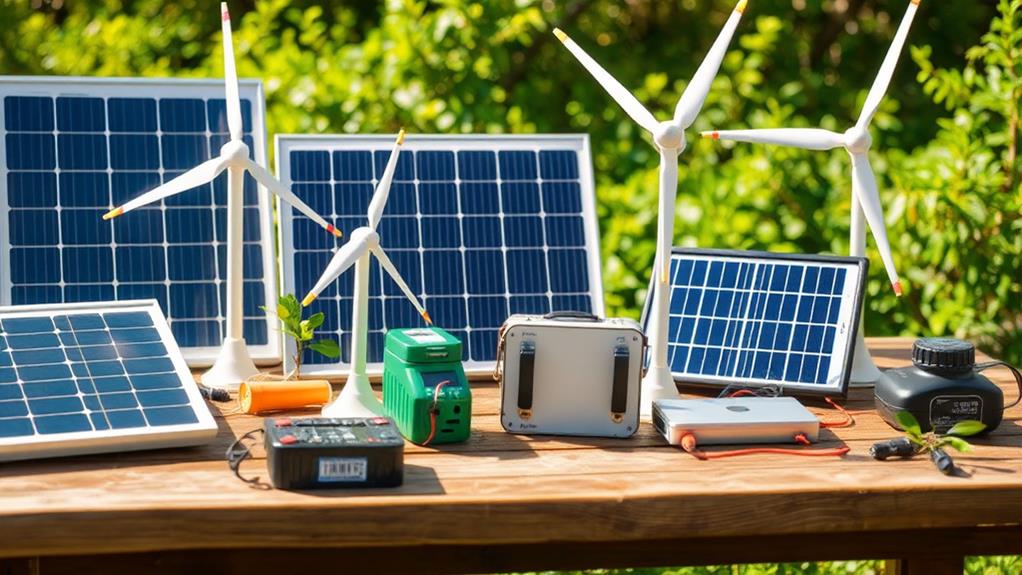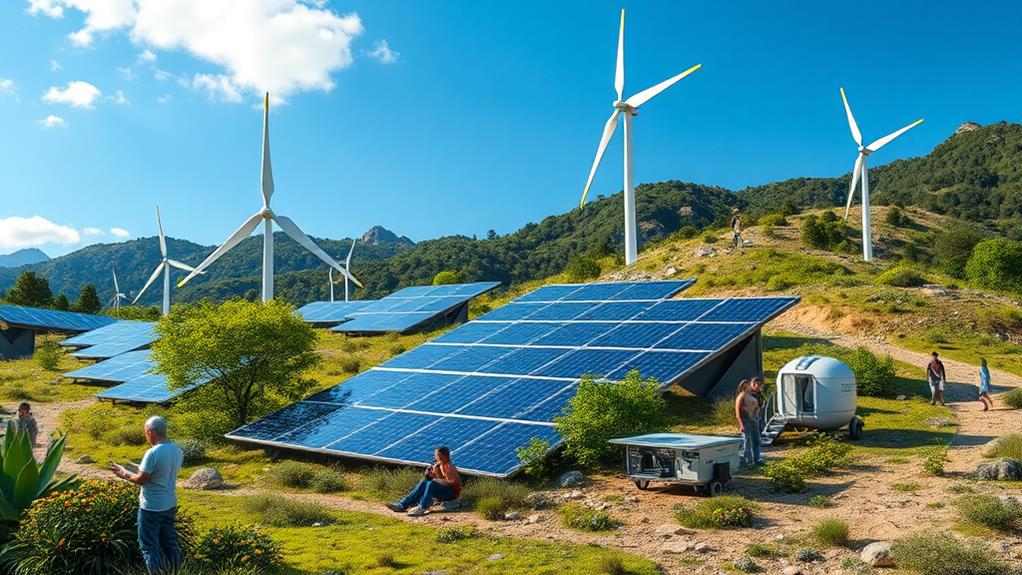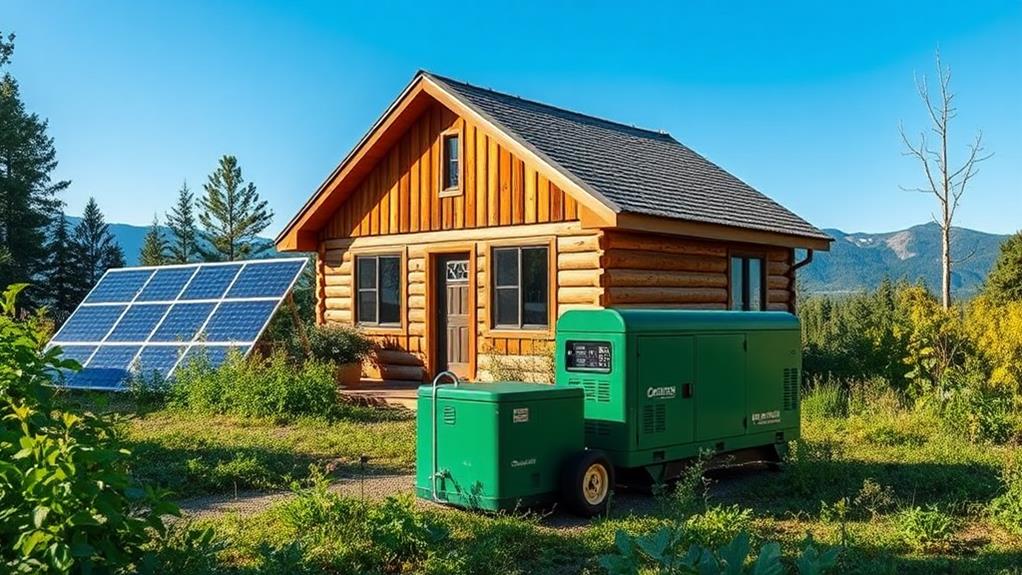We see that the top portable eco-friendly power sources include solar generators, wind generators, biofuel generators, and hybrid systems. Solar generators, utilizing photovoltaic panels, provide silent, efficient power, while wind generators harness local wind currents for energy production. Biofuel generators, converting organic waste into energy, enhance waste management and reduce methane emissions. Consequently, we recommend considering products like the Kery Explorer 2000 Plus and EcoFlow Delta 3 Plus for reliable energy storage. Key features to evaluate encompass power output, battery capacity, and multiple charging options. Each option meets various application needs, illustrating the potential for sustainable energy solutions in modern life.
Key Takeaways
- Solar Generators: Utilize photovoltaic panels for silent, efficient energy, ideal for off-grid applications and outdoor activities.
- Wind Generators: Harness wind currents, suitable for specific locations, offering a sustainable power source with minimal environmental impact.
- Biogas Generators: Convert organic waste into energy, reducing landfill waste while providing a renewable energy source.
- Hybrid Generators: Combine solar and wind technologies for enhanced efficiency, ensuring reliable power from multiple renewable sources.
- Biofuel Generators: Use biodiesel or ethanol to produce energy, emitting fewer pollutants and offering quieter operation for outdoor use.
Importance of Portable Power Sources
Portable power sources are increasingly becoming essential in our daily lives, especially during emergencies. These devices, such as portable power stations, offer reliable emergency backup power, enabling us to maintain connectivity and function in critical situations. They allow us to power multiple devices simultaneously, from smartphones to small appliances, ensuring we stay connected and safe. Additionally, these eco-friendly options greatly reduce our environmental impact by emitting minimal to no greenhouse gases compared to traditional fossil fuel generators. By utilizing clean power solutions, we contribute to sustainability while enjoying the convenience of versatile charging capabilities. As technology advances, we can expect even faster recharge rates and greater battery capacities, making portable power sources an invaluable addition to our lives.
Overview of Eco-Friendly Options

As we explore the landscape of eco-friendly power sources, we’ll examine the various types of generators available, from solar and wind systems to biogas and hybrid options, each presenting unique benefits. These renewable energy solutions not only reduce our carbon footprint but also enhance energy security by providing reliable power in diverse applications. Additionally, we’ll consider key factors to keep in mind when purchasing these systems, ensuring we make informed decisions that align with our sustainability goals.
Types of Eco-Friendly Generators
When it comes to eco-friendly power sources, we have several innovative options to contemplate. Solar generators stand out, utilizing photovoltaic panels to convert sunlight into electricity, providing a silent and efficient solution for off-grid living and backup power. Wind generators, reliant on consistent wind currents, require open spaces for installation, making them ideal for specific locations. Biogas generators transform organic waste into energy, mitigating landfill waste and offering a renewable energy source. For versatility, hybrid generators combine solar and wind technologies to enhance energy efficiency. Finally, portable generators are lightweight, compact, and designed for outdoor activities, delivering an eco-friendly solution without fossil fuel dependence. Together, these options empower us to make sustainable choices in our energy consumption.
Benefits of Renewable Energy
There are numerous benefits to embracing renewable energy sources that can greatly enhance our lives and the environment. By shifting to renewable energy, we not only reduce our dependence on fossil fuels but also considerably lower emissions compared to traditional energy sources. The advantages include:
- Minimal to no greenhouse gas emissions, leading to a cleaner atmosphere.
- Solar and wind generators operate silently, providing eco-friendly options for off-grid applications.
- Biogas generators address waste management while reducing methane emissions from landfills.
Incorporating these renewable energy solutions, such as solar and wind, demonstrates our commitment to sustainability and energy independence, fostering a sense of community among those who prioritize eco-friendly practices. Together, we can make a meaningful impact on our world.
Key Purchase Considerations
In exploring eco-friendly power sources, we should consider several key factors before making a purchase. First, evaluating the type of renewable resources available is essential, as this impacts the overall efficiency of our energy solutions. For instance, portable solar generators are ideal for silent, off-grid applications, leveraging photovoltaic panels to maximize power output. In addition, we should assess the charging options provided by each model, ensuring compatibility with our devices. Moreover, hybrid generators, which combine multiple renewable sources, offer enhanced reliability for diverse needs. Finally, understanding the operational conditions of wind generators, which require strong currents and open spaces, is vital. By considering these factors, we can make informed choices that align with our commitment to sustainability.
Solar-Powered Chargers

Solar-powered chargers have become a game changer for outdoor enthusiasts who want to stay connected without sacrificing their eco-friendly values. These devices allow us to harness the sun’s energy, providing reliable portable power for our electronic needs during backpacking adventures. Particularly, many models feature multiple USB ports and integrated LED lights, enhancing their utility.
- The BioLite SolarPanel 5 includes an integrated battery for versatile charging needs.
- The PSOOO charger offers a remarkable 50,000 mAh capacity, accommodating simultaneous device charging.
- Lightweight designs, such as the XDragon 20W, facilitate ease of transport without compromising power output.
With energy conversion rates typically around 20%—and advanced models reaching 23%—solar chargers represent an efficient solution for our off-grid power requirements.
Biofuel Generators

As we explore biofuel generators, we find that they offer significant advantages, including reduced emissions and quieter operation, making them particularly suitable for outdoor applications. These generators primarily utilize biodiesel derived from vegetable oils or animal fats, which can lead to long-term savings despite higher initial costs. Additionally, understanding the types of biofuels used and their implications for performance, such as the need for larger fuel tanks due to biodiesel’s lower energy density, is essential for optimizing their efficiency and reliability.
Advantages of Biofuel Generators
When we consider portable power sources, biofuel generators stand out for their eco-friendly advantages. These generators not only utilize biodiesel derived from vegetable oils or animal fats, but they also greatly reduce emissions compared to traditional gasoline generators. This makes them particularly appealing to eco-conscious travelers who prioritize sustainable travel practices.
Some key advantages include:
- Lower Emissions: Biofuel generators emit fewer sulfur oxides and particulates, enhancing air quality.
- Quieter Operation: They operate quietly, making them ideal for camping and outdoor activities.
- Sustainable Materials: Using renewable resources contributes to a more sustainable energy future.
Types of Biofuels Used
Continuing our exploration of biofuel generators, it’s vital to understand the specific types of biofuels that power these eco-friendly machines. One of the most common biofuels is biodiesel, which is derived from vegetable oils or animal fats. Biodiesel offers reduced emissions compared to traditional gasoline and notably lowers sulfur oxide and particulate emissions, enhancing air quality. Many generators also support dual-fuel setups, allowing for flexibility with fuel choices. It’s important to note that while biofuels are renewable sources, they generally have a lower energy density, which can affect runtime. Regular maintenance, such as fuel filter changes and engine tuning, is critical for peak performance.
| Biofuel Type | Key Features |
|---|---|
| Biodiesel | Derived from oils/fats |
| Ethanol | Fermented from plant materials |
| Biogas | Produced from organic waste |
| Biomass | Solid fuels from organic matter |
| Syngas | Gasified biomass/coal |
Best Portable Power Stations

Finding the best portable power stations can feel overwhelming with so many options available today. However, we can simplify our choices by focusing on a few standout models that cater to various needs and preferences.
- Jackery Explorer 2000 Plus: Offers an impressive battery capacity of 12,256.8Wh, making it the best overall choice for off-grid applications.
- EcoFlow Delta 3 Plus: Known for its fast charging, reaching 80% in just 45 minutes, and a capacity of 1,024 watt-hours.
- Jackery Explorer 1000 Plus: A versatile option for everyday use, providing a rated output of 1,000 watts.
Key Features to Consider

Considering the variety of portable eco-friendly power sources available, it is important to focus on key features that meet our specific needs. First, we should assess the power output, aiming for a minimum of 200 watts to efficiently support multiple devices, particularly larger appliances. Additionally, a battery capacity of at least 300 watt-hours is necessary for operating essential devices during outages or off-grid excursions. We must also guarantee a diverse port variety, including multiple AC outlets, USB-A, and USB-C ports, to accommodate various charging requirements. Recharge options, particularly solar inputs, enhance versatility and sustainability, especially during outdoor activities. Finally, we should prioritize weight and portability, selecting models that weigh no more than 50 pounds for effortless transport.
User Experience and Performance
Often, user experience and performance are critical when selecting a portable eco-friendly power source. We find that models like the EcoFlow Delta 3 Plus excel in charging speed, reaching 80% capacity in just 45 minutes. This feature greatly enhances our experience during emergencies. Meanwhile, the Jackery Explorer 1000, with its 1,000-watt output and multiple ports, allows us to charge several devices simultaneously, making it indispensable for both outdoor activities and urgent situations. Additionally, user-friendly interfaces, such as the brightly lit screens in the EcoFlow Delta 1300, simplify energy monitoring. Key aspects that contribute to our overall satisfaction include:
- Fast charging capabilities
- Lightweight and portable design
- High efficiency in power output
These factors collectively enhance our engagement with portable power solutions.
Future of Portable Green Energy

As we look ahead, the future of portable green energy appears promising and full of innovation. The portable power station market is projected to reach $1.5 billion by 2026, reflecting our collective demand for eco-friendly energy solutions. Innovations in solar technology are considerably enhancing efficiency, with some portable solar chargers achieving conversion rates up to 23%, making them ideal for off-grid applications. Additionally, hybrid generators combining solar and wind energy are gaining popularity, offering versatile clean energy generation options. The rise of biofuel-powered generators, which emit 50% less than conventional diesel, highlights our commitment to sustainability. Moreover, advancements in lithium iron phosphate batteries guarantee longer lifespans and enhanced safety, solidifying our path toward a greener future.
Frequently Asked Questions
What Is the Most Powerful Eco Flow?
When we think about the most powerful EcoFlow, we consider its impressive capacity, portability, and features. Pricing varies, but comparing models helps us find the perfect balance between power and our needs.
Which Is Best Ecoflow or Jackery?
When we consider EcoFlow advantages and Jackery features, we find both brands excel in battery lifespan and portability. While EcoFlow charges quickly, Jackery often wins on price. It really depends on our specific needs and preferences.
Is Bluetti or Jackery Better?
When we took our camping trip, we noticed Jackery’s advantages in portability and battery longevity. While Bluetti features higher capacities, user reviews often highlight Jackery’s ease of use, making it a favorite among our friends.
What Is the Most Efficient Power Station?
When we explore efficient power stations, we consider solar panel efficiency, battery capacity comparison, and renewable energy trends. Together, let’s plunge into portable charger reviews and environmental impact analysis to find our best options.




